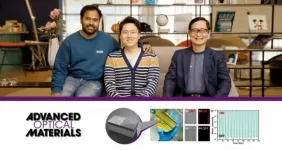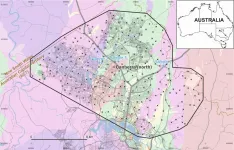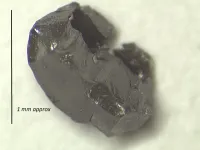(Press-News.org) In a retrospective, multi-centre cohort study conducted by researchers from Nanjing University, Huazhong University of Science and Technology, Jinling Hospital and the Second Hospital of Nanjing, a microRNA-like small RNA encoded by SARS-CoV-2 was identified in the serum of COVID-19 patients, which can be developed as a non-invasive biomarker for stratification of severe patients from mild/moderate ones and for identification of high-risk individuals before clinical manifestation of severe symptoms. This biomarker ensures proper allocation of patients to different levels of medical facilities and allows more effective control of the pandemic and relief of social economic burdens.
COVID-19, caused by SARS-CoV-2, evolved into a global pandemic in 2020-2021. Although most COVID-19 cases are mild, some patients rapidly develop acute respiratory distress syndrome and other serious complications, leading to multiple organ failure and even death. Since medical facilities do not have reliable biomarkers to predict likelihood of disease progression and identify high-risk patients that require immediate medical attention, patients can only be treated after the appearance of severe symptoms, thereby missing the best treatment window. Furthermore, because patients cannot be stratified at admission, they have to be quarantined and treated without screening, which often leads to high pressure on healthcare services. To improve treatment outcome, reduce the mortality rate and prevent a total failure of the overwhelmed health services, it is essential to prioritize the patients at higher risk of developing life-threatening COVID-19 disease.
This study provides just this, a reliable early prognostic biomarker for COVID-19 severity. This biomarker is a microRNA-like small RNA encoded by SARS-CoV-2 virus, named miR-nsp3-3p, which is exclusively present in the serum of severe patients but not in non-severe patients and healthy controls. MiR-nsp3-3p is superior to the conventional biochemical characteristics (e.g., D-dimer, CRP, LDH and PLC) for stratification of severe patients from mild/moderate ones. More importantly, miR-nsp3-3p can capture the risk of critical illness far ahead of clinical manifestation of severe symptoms, exhibiting a significantly higher prediction horizon (7.4 days in advance) and higher accuracy (97.1%) than conventional indexes.
The critical points of this study are highlighted below:
(1) COVID-19 patients typically suffer from a sudden deterioration into a severe illness. Predicting whom amongst COVID-19 patients will progress towards this severe downturn will provide a significant advantage to prevent the overwhelm of the hospitals and to provide optimized treatment to patients. MiR-nsp3-3p is a consistent prognostic biomarker, more precise and reliable than D-dimer, CRP, LDH and PLC. Most importantly, miR-nsp3-3p identifies the risk of critical illness early on the evolution of the disease. Early detection of miR-nsp3-3p indicates the higher risk of the patient to develop a critical illness, enables prioritizing the patient for special care, and hence improves treatment outcome and reduces the mortality rate.
(2) Although some researches have shown that multi-omics analyses (transcriptomics, proteomics and metabolomics) can be used to characterize severity status, these techniques are too complex for rapid and general application in the pandemic. Because miR-nsp3-3p exhibits comparable sensitivity, specificity and precision to that of multi-omics, and because the quantification protocol is simple requiring only a small amount of serum, this new biomarker can be readily applied in the current COVID-19 pandemic and expectedly provide a simple mean to conveniently monitor disease progression in COVID-19 patients.
(3) SARS-CoV-2, as a RNA virus, is evolving fast and now more transmissible variants like delta variant are becoming dominant in many regions. Since miR-nsp3-3p is highly conserved among different SARS-CoV-2 strains, it can be applied in the current pandemic as a reliable biomarker regardless of the emergence of a new variant of SARS-CoV-2.
(4) Being a reliable prognostic biomarker, miR-nsp3-3p can be used to support decision-making and logistical planning in healthcare systems and facilitate more precise prevention and control of the epidemic, especially in deprived regions with shortages of medical resources.
INFORMATION:
This work was supported by grants from the National Natural Science Foundation of China (No. 32022015, 32001077, 31871295, 21877060, 81250044 and 81602697), the National Basic Research Program of China (973 Program) (2014CB542300), the Fundamental Research Funds for the Central Universities (020814380125, 020814380130, 020814380133 and 020814380146), the Chinese Science and Technology Major Project of China (2015ZX09102023-003), the Key Foundation of Wuhan Huoshenshan Hospital (2020[18]), and the Emergency Key Technologies R & D Program of Huazhong University of Science and Technology (2020kfyXGYJ099). A provisional patent has been submitted based on this work.
Fu et al. "A virus-derived microRNA-like small RNA serves as a serum biomarker to prioritize the COVID-19 patients at high risk of developing severe disease" Publishing on Cell Discovery, 6 Jul 2021.
A research team, led by Professor Dai-Sik Kim in the Department of Physics at UNIST has developed a new technique of predefining the crack pattern on a flexible substrate by a sequential deposition of metallic layers which leads to a formation of a "zero-nanometer gap, or a "zerogap," between the adjacent lateral patterns.
These gaps, according to the research team, readily open and recover with gentle bending and relaxing of the flexible substrate, precisely along the rims of the pre-patterns of centimeter lengths. Furthermore, in a prototypical pattern of densely packed slit arrays, these gaps serve as antennas achieving transparency for polarizations perpendicular to the length of the gap when opened ...
Chemical elements make up pretty much everything in the physical world. As of 2016, we know of 118 elements, all of which can be found categorized in the famous periodic table that hangs in every chemistry lab and classroom.
Each element in the periodic table appears as a one-, two-letter abbreviation (e.g. O for oxygen, Al for aluminum) along with its atomic number, which shows how many protons there are in the element's nucleus. The number of protons is enormously important, as it also determines how many electrons orbit the nucleus, which essentially makes the element what it is and gives it its chemical properties. In short, the atomic number is an element's ID card.
The periodic table ...
A new organic (carbon-based) semiconducting material has been developed that outperforms existing options for building the next generation of biosensors. An international research team led by KAUST is the first to overcome some critical challenges in developing this polymer.
Much research effort is currently expended into novel types of biosensors that interact directly with the body to detect key biochemicals and serve as indicators of health and disease.
"For a sensor to be compatible with the body, we need to use soft organic materials with ...
Networks of ground-based sensors paired with airborne drones could give firefighters a critical edge when battling wildfires, KAUST researchers have found. The sensor/unmanned aerial vehicle (UAV) network could significantly shorten the time taken to detect a wildfire, giving firefighters a better chance to contain the fire before it grows too large to control.
Wildfire detection is currently performed mainly by satellite imaging and remote cameras, but these technologies can be impeded by cloudy weather and fires can grow to a considerable size before they are spotted. With the recent significant global ...
The surprising results of a decade-long investigation by Alessandro Vezzosi and Agnese Sabato provide a strong basis for advancing a project researching Leonardo da Vinci's DNA.
Their extensive study, published by the journal "Human Evolution" (Pontecorboli Editore, Florence), documents with new certainty the continuous male line, from father to son, of the Da Vinci family (later Vinci), from progenitor Michele (born 1331) to grandson Leonardo (6th generation, born 1452) through to today -- 21 generations in all, including five family branches -- and identifies 14 living descendants.
The work fills gaps and corrects errors in previous genealogical research into Leonardo's family, while ...
A new study shows how urbanisation has influenced anthropogenic CO2 and air pollutant emissions across all world regions, by making use of the latest developments in the Emissions Database for Global Atmospheric Research (EDGAR, https://edgar.jrc.ec.europa.eu/) developed by the Joint Research Centre of the European Commission. The results show that by 2015 urban centres were the source of a third of global anthropogenic greenhouse gases, and the majority of air pollutant emissions.
The authors, from institutions in France and Italy, used the EDGAR database to provide a country-to-global ...
Researchers at Karolinska Institutet in Sweden publish new findings in the journal Cancer Discovery showing how pharmacological activation of the protein p53 boosts the immune response against tumours. The results can be of significance to the development of new combination therapies that will give more cancer patients access to immunotherapy.
Given its ability to react to damage to cellular DNA and the key part it is thought to play in preventing tumour growth, the protein p53 has been dubbed the "guardian of the genome". Half of all tumours have mutations in the gene that codes for the protein, and in many other tumours, p53 is disabled by another protein, MDM2.
It has long been known ...
Scientists have taken the first steps in developing a new method of identifying the movements of criminals using chemical analysis of soil and dust found on equipment, clothing and cars. The locating system allows police or security services to match soil remnants found on personal items to regional soil samples, to either implicate or eliminate presence at a crime scene. The work is presented as a Keynote Lecture at the Goldschmidt Geochemistry Conference, after recent publication.
Dr Patrice de Caritat, Principal Research Scientist at Geoscience Australia, Australia's public sector geoscience organisation, said:
"We've ...
A unique study of ancient diamonds has shown that the basic chemical composition of the Earth's atmosphere which makes it suitable for life's explosion of diversity was laid down at least 2.7 billion years ago. Volatile gases conserved in diamonds found in ancient rocks were present in similar proportions to those found in today's mantle, which in turn indicates that there has been no fundamental change in the proportions of volatiles in the atmosphere over the last few billion years. This shows that one of the basic conditions necessary to support life, the presence of life-giving elements in sufficient quantity, appeared soon after Earth formed, and has remained fairly constant ever since.
Presenting the work at the Goldschmidt ...
Below please find summaries of new articles that will be published in the next issue of Annals of Internal Medicine. The summaries are not intended to substitute for the full articles as a source of information. This information is under strict embargo and by taking it into possession, media representatives are committing to the terms of the embargo not only on their own behalf, but also on behalf of the organization they represent.
1. Infusion centers associated with substantially better outcomes than the ER for patients with acute pain events and sickle cell disease
Abstract: https://www.acpjournals.org/doi/10.7326/M20-7171
Editorial: https://www.acpjournals.org/doi/10.7326/M21-2650
Summary: ...





